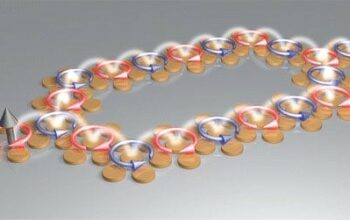In recent explorations of magnetism, a remarkable phenomenon has emerged known as “bubble breakthrough,” a process associated with fluid collapse that presents novel insights into the behavior of certain materials under extreme conditions. Traditional magnetism, which fundamentally rests upon the alignment of magnetic moments in the atomic structure of materials, has long captured the attention of physicists due to its ubiquitous presence and significant applications across various technological fields. However, the revelation of bubble dynamics in magnetic systems introduces a compelling narrative that challenges established paradigms and invites deeper inquiry into the fabric of magnetic interactions.
The genesis of bubble breakthrough can be traced to the complex interplay between temperature, pressure, and fluid dynamics specifically in ferromagnetic materials. When subjected to specific thermal and mechanical conditions, microbubbles can form within a magnetic medium. These bubbles, often appearing in liquid-like forms due to the fluid nature of the host material, become sites of intense study due to their enigmatic properties. The fluid collapse, which occurs when these bubbles contract rapidly, engenders fluctuations in the local magnetic field, leading to intriguing ripple effects throughout the surrounding environment. The collapse of these bubbles is not merely a mechanical failure; it unleashes kinetic and potential energies that can significantly alter the magnetic properties of the substance.
The physiological foundation of this phenomenon is grounded in the principles of thermodynamics and magnetohydrodynamics, where the interactions between magnetic fields and conductive fluids are harnessed. Under critical conditions, the interplay between these forces can lead to instability in the bubble structure, giving rise to a cascade of events that challenge our understanding of magnetism. This phase transition, reminiscent of critical phenomena in statistical mechanics, showcases the delicate balance held within these systems. Not only do such transitions provide insights into macroscopic behaviors, they also furnish a microscopic understanding that illustrates the profound implications of fluctuations at the atomic level.
A quintessential observation in magnetic systems is the so-called “magnetic hysteresis,” which describes the lag between the application of a magnetic field and the resultant magnetization of a material. The introduction of dynamic bubbles alters the landscape of hysteresis, giving rise to unconventional magnetic responses. For instance, as bubbles coalesce and collapse, they induce localized variations in magnetization, which can result in unconventional “magnetic memory” effects in materials previously thought to be static. This unforeseen complexity suggests that the relationship between magnetism and fluid dynamics is not simply ancillary, but rather foundational to the understanding of magnetic materials.
Furthermore, researchers have noted that the bubble dynamics induce a form of “magnetic turbulence,” an effect that results in non-linearities within the magnetization curves. This phenomenon can be likened to chaotic behavior observed in fluid dynamics, leading scientists to inquire whether the underlying principles governing these systems could be unified under a broader theoretical framework. The implications are profound, hinting at potential applications in spintronic devices, where information processing is contingent upon the manipulation of spin states within materials.
Moreover, the exploration of bubble breakthrough transcends fundamental physics; it beckons the investigation of its practical applications. As the understanding of these dynamic interactions evolves, there is the potential for developing advanced magnetic materials with tailored properties. For example, if one could harness the desired bubble collapse characteristics, it might be feasible to engineer ferromagnets that exhibit enhanced sensitivity to external magnetic fields, paving the way for the creation of next-generation sensors and magnetic resonance imaging technologies.
As enthusiasm for this research intensifies, experimental techniques are evolving to probe into these phenomena with greater precision. Quanta of energy released during bubble collapse may be harnessed to understand and manipulate magnetic states, further bridging the gap between theoretical predictions and practical implementations. High-resolution imaging technologies and real-time observation tools have become invaluable assets in this endeavor, allowing scientists to visualize and quantify bubble behavior under varied magnetic environments.
Additionally, the study of bubble dynamics within magnetic materials broadens our comprehension of thermodynamic processes at macroscale phenomena. It encourages a multidisciplinary approach, inviting contributions from fluid mechanics, condensed matter physics, and materials science to collaboratively unravel the intricacies of this phenomenon. This synthesis of disciplines is imperative, as complex magnetic behaviors or bubble dynamics may intersect with biological systems—where magnetic interactions and fluid dynamics play critical roles, potentially revealing insights into natural patterns and processes.
In conclusion, the bubble breakthrough phenomenon characterized by fluid collapse within magnetic materials unveils a rich tapestry of experimental and theoretical inquiry. It addresses commonplace observations in magnetism and unveils an underlying complexity that harkens to the essence of physical inquiry. The pursuit of knowledge in this domain not only embodies the refinement of established theories of magnetism but also challenges the conventions that define our understanding of physical interactions within materials. The interplay between magnetic phenomena and fluid dynamics serves as a testament to the inexorable curiosity that propels scientific advancement, heralding a new chapter in the understanding of magnetism’s intricate role in the physical universe.












